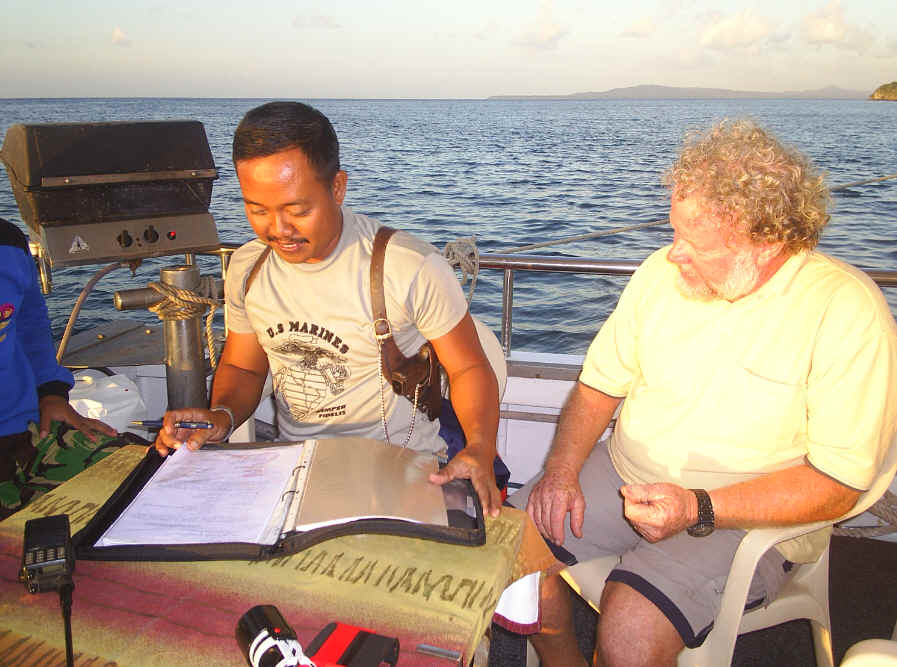
18 August 2005
Life’s good. We’re sliding over 2m swells on our stern quarter with frothy bits of whitecaps from a 15-20 knot breeze, 120 nm SE of Leti Island in Indonesia. Sailors we’re not. But how lovely these conditions would be if you were. We’ve been sitting on a steady 6.9 knots all day – but no thanks to this beautiful breeze.
Not so yesterday and last night. After we left Fannie Bay at 8.30am, a seabreeze (?) from the NE sprang up. Not a particularly large sea but on the beam. The windward side of the cockpit managed to meet a wave just at the right time for it to break over the rails into the cockpit and up over the door ledge a metre and a half into the saloon. We had our door open of course, as we always do. Bummer. A bit of mopping up (the carpet is nearly dry now in this warm weather) but my heart was in my mouth for a while. Philip has now pumped fuel from the back tanks into the day tank – we think we were probably riding a bit lower than usual with a full load of fuel.
A catamaran (Arctracer) who happened to have set off for Indo around the same time, left us in their wake as the wind steadied around 20 – 25 during the day. But as soon as we got to the bottom of Bathurst Island, it funnelled around – absolutely dead on the nose from the NORTH.(And we overtook the catamaran). So much for the SE trades. We travelled less than 5 knots for six hours slamming into a “moderate to rough sea” (as the BOM called it) and in the dark of course. But we did have a bright full moon all night.
By morning, after we had finally left any land influence, it had abated. There have been signs of a few showers up ahead and we hope we might catch one to rinse some of the salt off.
Today, between sleeps, I’ve been working on an immediate-use Indonesian vocab. Despite my best intentions and some early work, I haven’t been as diligent at learning as I should. But now the time has come. Within 24 hours we will have to use the radio to call or respond to the harbourmaster (Syabandar) at Leti. Amazingly the tourist phrase book doesn’t include “go to channel 17”.......
Whoops! Time to do a log entry and have a look around. Tomorrow morning we should be able to see Leti.
INDONESIA
Leti Island 9pm 19/8/05
Our first nine hours in Indonesia has already provided enough stories that we could dine out for a year. After driving along near the edge of a coral reef (in 800m of water!) that edged the shore of Leti Island, we found the “football field sized” patch of sand that we had been told about by cruisers in Darwin who had just come from here. We anchored in 7.5m about 300m from the beach at 12.15pm. The water is crystal clear.
As we ran along the side of the reef looking for our anchor spot, we could see through our binoculars that the villages run along the shore with steep hills behind. Thatch roofed houses hide beneath coconut palms and three picturesque red tiled churches perch on higher points right on the edge of the water. I could smell the aroma of boiling sago.

Bapak Bambang inspecting our papers.
We weren’t quite sure why we were there as they had come to the boat and looked at our papers earlier. Bapak Bambang was also unsure I think, but he asked us a few questions, welcomed us some more, smoked some cigarettes, told us to radio “alpha lima” if we had any problems at all and they would come. (AL are the intials for the navy in Indonesian). With Ardi as interpreter he also suggested that the navy men might accompany us to Moa (an adjacent island) to view the “Buffalo mountain” and Lakor to view an island that looked like a goat. He then waved us goodbye as we set off with Ardi for the Police office.
The roads in the town are paved with what appears to be a concrete/bitumen mix with crushed coral aggregate. Each office or house is neatly fenced in some way with perhaps waist high bamboo stakes, hand made blocks or, in some cases, fancy concrete pillars. The land, where we would have grass, is swept dirt, often with garden beds around. Paths may be crushed shells with edging of painted clam shells. Innovation and making do seems to be the name of the game with building materials and landscaping. Houses have thatched or iron hip roofs. Several houses share a well.
Like the navy office, the police office was a small slightly decrepit structure, painted lemon with brown writing, and in the midst of having additions. The desk and stools were on the front verandah. Ardi went in to roust up the police who tumbled out looking a little sleepy and nothing like any police we’ve ever seen. Like the navy men they were all young. One had a pierced ear, long shorts and thongs and no one was in a uniform. Cigarettes on the table, they were also a bit bemused as to what to ask and do. Bapak Etoc looked at our passports, noting our names as Sue Anne and Philip John. He asked us some questions about where we were going to travel and studied any papers we had to show him. When we asked about a SIB, he conferred with his boss, Bapak Daut, who said they would give us one. From then on B. Daut would ask a question and disappear out the back to an anonymous typist who we could hear tapping slowly in the background for the next hour!. We offered our Benson and Hedges 16mg cigs around, which everyone tried but only Daut liked and we read the packets of their cigarettes and ours to see which were stronger.
Meanwhile Etoc disappeared in response to a call and reappeared with an AK 47 which he gave to another policeman (Pierced Ear). Ardi explained that it was to shoot a “mad duck” which was biting people. (The mad duck turned out to be a mad dog).
Bapak Daut then offered to lend us the police motorcycle to tour the island and see where the sopi was made. Ardi explained that sopi (distilled spirit from the coli tree) was the only thing manufactured in Leti that was traded with the other islands and that everything, including sopi, was produced as cottage industry by individual families.
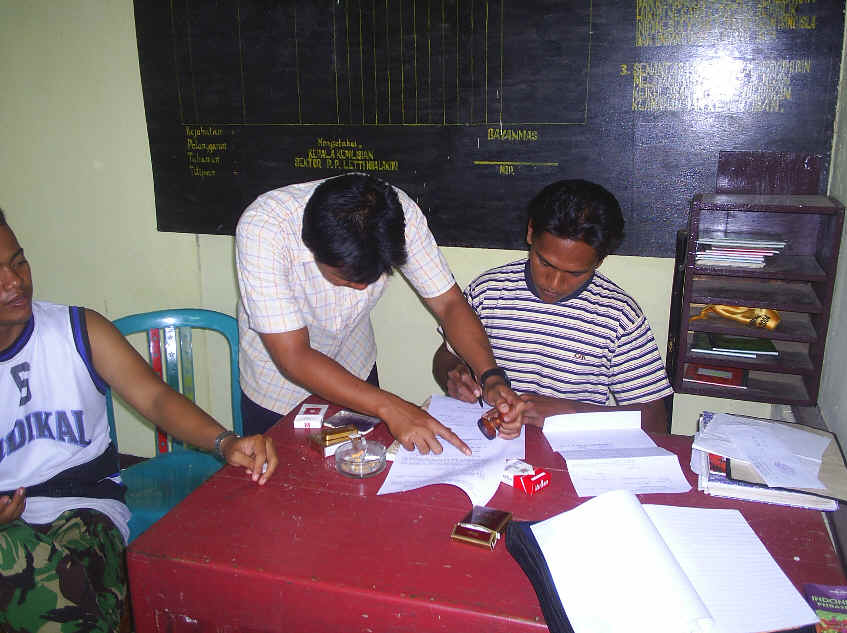
Bapak Daut stamping our form at the police station.
Ardi, on the other hand, was artfully hinting (a little incongruously I thought at the time) that the sunset over the water was beautiful. Eventually, as we were thick as bricks, he suggested that the police might like to see the boat. We readily agreed and we all walked down to our dinghy in the dark to find that, in these spring low tides, we were on the beach and a hundred yards from the water. Not so problem. A dozen men and boys suddenly materialised and we literally carried the tinnie to the water, whereupon Daut, Etoc and Ardi climbed aboard for the ride out to Lifeline.
Our first 9 hours in Indonesia was spent with officials, yet we were charmed by them and their anxiousness to help and please us. They see so few tourists (ie none), let alone those who arrive on a small boat, that they are mostly interested to talk and look at how we live as well as show us their life. It is intense though. We can’t learn all the Indonesian words we need quickly enough. Tough on Ardi too, being the only English speaker in town. He has explained to us that it is his job to represent Indonesia and that Indonesia is not full of terrorists and bad people like in the news.
After about half an hour Syabandar and Ardi accompanied us down the road to the wartel, a type of privately owned “communications centre” which they apparently have all over Indonesia, as well as, in some places, government owned Telkom. At this wartel there is one phone on a man’s desk attached to a meter – the only phone in Leti – a satellite connection. We were warned that it was “very expensive” and it was, even by Australian standards (R52,000 - $7 for 2 minutes). Philip wanted to ring his Mum to put her mind at rest and ask her to let Tim know that we had arrived safely. A crowd quickly gathered in the shop as Philip stood at the desk next to the owner and plastic chairs were hastily pulled out for everyone else. An international satellite phone call is probably a rare occasion in a village like Sarawoe.
The army man was from Java but had an “adopted mother” at Leti, an older lady he introduced us to as Marcella, from Saumlaki and to whom he was affectionate. Although he spoke some English words and phrases confidently and well, we still relied on Ardi to translate. He kept repeating “You came straight here from Australia. In a small ship. I don’t believe it”. At this stage I was a little nervous that he “didn’t believe” us and wondered if he was going to make trouble.
Next Ardi walked us to another, much smaller “shop” a few streets away, a bamboo shed with a door and lift up shutter a la mobile pie van. It sold only eggs and some home made cake and dessert (ie my style of shop). We bought sweet buns filled with a coconut mixture and promised to try their green coconut ice later. Ardi explained that this was his adopted family. Here we ate and waited for Daut with the police motorbike and Ardi to get another motorbike. They then doubled us to the next village, Tombra, to find someone making sopi.

The Sweet shop at Leti.
Several places along the track the villagers were building “arches” across the road, from either rendered concrete blocks or bamboo “tiles” which would sport signs like “Selamat Datang” (Welcome). We asked if this was some government sponsored program as there were already several along the road in Serawoe and here. But Ardi said no, they just like to do it. Clearly it’s not for the tourist trade.


Arch over the road in the sopi village. Sopi still.
After finding a family in the process of making sopi, we were led past the back of their house along a winding dirt track half a kilometre through sparse grass lightly treed with cabbage tree palms (Coli). There, under a palm frond thatched bamboo lean-to was the still, a 20 litre steel drum heated from below by a fire. At the top of the drum was a metal pipe to collect the steam, connected to a run of bamboo pipe where the vapour cooled and came out as distilled spirit. There are three classes of sopi (we think, depending on the number of times it is run through the still). The first class sopi is 75% alcohol, which they demonstrated by throwing on the fire, which flared up on cue. A young boy was sent up a nearby cabbage tree palm to get a long thin seed pod. The maker then demonstrated how he sliced it with his sharp knife to get the juice. We tasted the raw juice and later sampled some first class sopi.
Finally we were led to the front yard of the house, where the rest of the village was lounging, given plastic chairs and offered fresh green coconut juice and sampled the flesh at different stages of ripeness. A visit to rival the Cadbury Chocolate factory tour.
Back aboard our bikes, we stopped at a 20 metre boat being built for the shopkeeper with the big ring under the trees near the beach on the side of the road back to Sarawoe. A dozen men were building a double skinned boat planked with 2” x 10” s, using adzes and power planers. The planks were fixed to the frames with bolts rather than the traditional dowels but the caulking was paperbark, tapped in and sealed over with epoxy! A couple of buffalo lay on the grass, tethered to a palm tree alongside planks and naturally grown and sawn knees. Philip asked about the cost of epoxy, having got a bargain (at $50 for half a litre) in Australia before we left. The men say they pay $3/litre.
Next stop was the three schools,
where, even though it was Saturday, the kids attend until 2pm. Ardi told me the
smart ones only have to go five days a week. There is a school for infants, one
for primary and one for high school kids. All the buildings were in very good
condition and the children were smartly uniformed in white shirts with red, navy
blue or light blue pants/skirts according to age. On the way back Ardi greeted
many people and told me that even though he came from Java he had many friends
on Leti Island and introduced me to his “bu” adopted brothers (not short for
“ibu” meaning mother).
Finally, after reminding us about the volleyball match that afternoon, Ardi and Daut dropped us back at our tinnie on the beach and we retired gratefully to Lifeline for the rest of the afternoon.
We speculated that sending
handsome, well behaved young army, navy and police officers to postings away
from home for 6 months at a time plus the system of adopting families, was a
clever way of integrating Javanese into communities. Apparently, once they marry
and have children they can stay in one spot where their families are.
Our visit to the volleyball
match did not come about – apparently there was some confusion about the time.
We were rather relieved because we expected the tide to leave us high and dry
again and weren’t so sure there would again be people to help us. Instead we
had a quiet beer and a BBQ on our back deck and watched little lights bobbing as
people searched for shellfish on the reef at low tide. That was followed by an
early night.
Suddenly, woken from sleep, in
the dark, there was noise – banging - against the boat, loud voices. We jumped
up. 2am Sunday morning. A dug out was pushing itself off our stabilisers. Many
boats circled us and yahooed. Too much sopi? I considered calling “Alpha
Lima” on the radio. Until we noticed a big ship (with nav lights) coming
towards us, lots of people and lights on the beach, Syabandar’s office lights
on and canoes and prahus racketing about all around us.
Within 15 minutes a 40m ship, its foredeck covered with a huge green tarp and lots of people on the decks, had anchored less than a hundred metres from us. The Perentis cargo vessel, Banda Neira, had arrived at Leti Island and passengers had come from islands all around. Within minutes the ship was surrounded by boats. Any that could get tied up to the sides, bow, stern did so, and passengers and goods began to jostle to the gunwhales of the ship while the rest circled or rafted to them, pitching in the swell that was coming around the corner of the island. Boats came close and at one stage we had quite a large prahu backing and filling across our bow up current from us and very close. Some of the slow firing diesels sound like firecrackers going off.
After the first flurry, the big derrick on the front deck, which arched across above the aforesaid tarp, was swung over the side, its lifting strop and hook directed into one of the small prahus tied on.
Within minutes a buffalo was
swung up, held by its horns, kicking and rotating up the side, over the opening
to the hold (which happened to be under the tarp where the people were) and
lowered down. We were astounded as, one by one, six buffaloes were winched out
of that tiny boat.
Meanwhile canoes propelled by
paddles or engines ferried people between the big boat, other boats and the
shore. The whole town seemed to be up and on the beach or on the boats. As each
boat went by our boat someone would yell mischievously, “Good morning”.
Gradually the boats and bustle
began to disappear, some heading to other islands. By 4 am it was all over. The
ship gave a couple of long blasts of its horn, upanchored and continued heading
east. We went back to bed.
Day 3 Leti 21 August
With no commitments, we planned
to spend the day listening to HF radio scheds for weather etc and catching up on
boat work as well as writing up this record and preparing some Indonesian
vocabulary for our early morning visit to the markets and our visit from the
army man and the shopkeeper the next day.
We were almost finished at two
o’clock, when they arrived exactly on time - but a day early. Clearly there
had been some confusion over time. Budi, the army officer arrived with Sammy the
shopkeeper and his wife Lan, their children Agnes and Andre and Gian, his
brother (?) harry and his wife(?) Yane and their friend Hua and a boat boy, in a
big tinnie. I didn’t recognise Budi out of uniform. (It was Sammy’s ring
that identified him.) They arrived with soft drinks and were very shy about
accepting coffee, tea, cake etc. (In fact I think they would have been quite
happy to just see the boat.) The women were very interested in seeing our
bedroom, the kitchen and bathroom and the fruit and tomatoes on the benches. The
men were especially interested in the radar, GPS and computer navigation
software. Unfortunately it was a bit rolly when they came and the children and
the women got sick, cutting the visit shorter than we all would have liked.
Monday 22 August 2005
At 6.30 am we visited the
market, which is on every day except Sunday from 6 am to 7 am. This is the time
of day when people are about, it seems. In the middle of the day and the
afternoon all seems quiet and we think many people sleep.
The market was very small –
maybe 15 people selling and perhaps as many buying. Small, shrivelled produce -
each person selling only one or two types: tiny tomatoes, small eggs, Asian
greens, cooking bananas, cut coconuts. The people were real Lettians we think,
as opposed to the officials and shopkeepers we had met up until then who were
without exception immigrants to Letti. These people were dark skinned with poor
teeth and did not seem to speak very good Bahasa Indonesia. One lady wanted to
feel Philip’s arm and skin. We bought a small bundle of nutlike things moulded
into a leaf. Very bitter – betel nut we think.
Later we went for a walk through
the houses on the tanjung at Sarawu. Thatched roofs and split bamboo siding or
hand made concrete blocks, all fenced with swept dirt yards and gardens. Some
had satellite dishes. Chooks, puppies, small pigs at some houses. I particularly
liked the scene of a pig eating from a giant clam shell in the garden.
We continued through the Tanjung out into the countryside. The paved road continues to another village. Either side of the road was open grassland sloping up to rocky hills, lightly timbered with Coli palms and coconuts. A few horses, goats and buffalo tethered in plots.
Later we visited Syabandar to get our SIB and went to the warung of Ardi’s adopted parents to try the “green coconut ice”, a confection of (dyed green) coconut pancakes wrapped around cooked bananas and sliced, placed on top of a bowl of hand shaved ice with rice custard and “Indo Milk” (Carnation?) poured on top and all crowned with a slurp of pink syrup. Delicious! (Really)
At the supermarket we bought 4 pkts Indo cigs (R8,000 each), a lighter, 6 cans of coffee flavoured creaming soda and 4 D-cell batteries. The principal of the local middle school (12- 15yrs) invited us to come and talk to the children about Australia the next morning at 8.30 am.
Tuesday 23 August 2005
We took Australian breakfast cereal, bread , cheese and snacks, a table cloth and setting and pantomimed Australian meals, at the same time giving the teachers and kids samples to try. It was very popular (particularly with the teachers). The children thirst for information. Their school is bereft of any books, pictures, resources of any kind. No daytime electricity so no photocopier, tape recorder, VCR, computers. But worst of all no books. The geography teacher had tears in her eyes as she looked at the Steve Parish books we had brought. They have nothing. And the children are so keen.
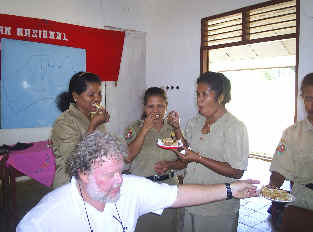
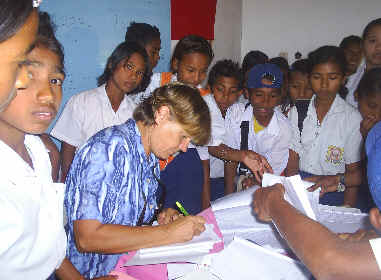 Signing
autographs
Signing
autographs
The teachers enjoyed trying Australian food as much as the kids

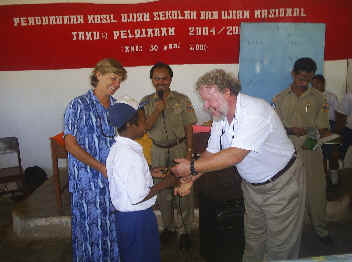 Philip
handing out a prize (swim goggles).
Philip
handing out a prize (swim goggles).
When we got back to Ardi’s
office, they had cooked lunch for us – a delicious spicy dish of sardines and
another dish of a green vegetable called Singkrom, also delicious. That evening,
Ardi and Bambang came back to the boat to stage a photo of them checking our
papers. The first ones were too dark and we couldn’t see Bambang’s pistol
properly. Ardi offered to bring his big gun but we said it might get wet in the
dinghy bringing it out. Ardi brought us some cakes he had made.
Letti generates its own
electricity (110 volts), but only from late afternoon and night. They export
sopi, copra and buffaloes to other islands.
Wednesday 24 August 2005 - Kisar Island
Five hours for a 30nm trip with current against us and an hour finding our anchor spot, we were settled at 3.30pm, just as the navy and the army arrived in their “speedboat”. Six handsome, friendly and eager young men (with three AK47s) took some details on paper borrowed from our exercise book and enjoyed being on the boat and having their photo taken before ferrying us to shore to see the Syabandar.
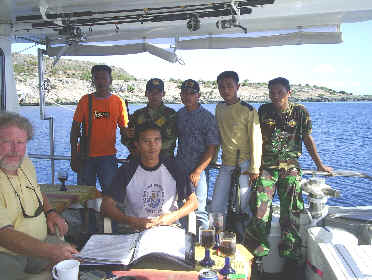
As a Perentis ship had arrived just before us, the harbour master was busy and we waited at the warung near the jetty for him. When he arrived, smartly dressed in uniform complete with name tag, he brought with him a policeman straight out of Hawaii Five O, in black T shirt, jeans and cap and fancy pistol on his hip. Both were called John.
The harbourmaster could not see us until 8.30 am the next day and the navy/army boys were assigned to pick us up.
Thursday 25 August
Only a little late, our boat arrived with its full complement plus Bobby Moses, whom we had said we wanted to visit while we were here. (An Australian couple we had met who lived on an Indonesian fishing boat at Gove had stayed at Kisar Island a lot and said they were Bobby’s “Second Family”. They asked us to give him their regards and said he would love any fancy bottles for his “bar”. We had a Dimple scotch bottle for him.)
Kisar was so unlike Letti. The Syabandar had a spacious airy office with a large organisational chart on the wall and seven staff who all sat at desks in the office with him. We sat in the waiting room with our entourage, learning Bahasa Indonesia, until he arrived at 10.00am. The actual production of the SIB (a signed and stamped photocopied half sheet of recycled paper, typed up with one of 3 typewriters by two female officers) was quite quick. We paid R50,000 to the assistant, Fenty, who spoke good English and were then sent to the police station in the village. But only after the group photo. (The young women also produced a camera and took photos of us).
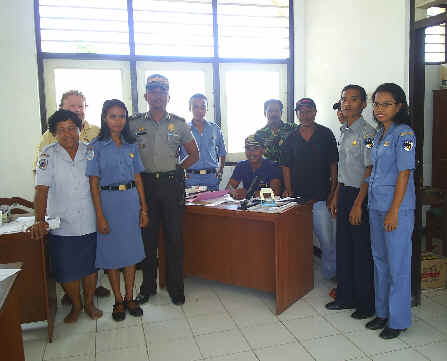
Syabandar John was very
handsomely uniformed again, but paled in comparison with John the policeman, who
had clearly dressed for the occasion in the tightest of skin tight khaki shirt,
tight khaki trousers, police baseball cap perched high on his head, polished
boots, badges, gun, bullets; mirror sunglasses tucked in his breast pocket and
aligned perfectly with his pen. He laughed when we said he looked like a movie
star.
Bobby Moses had arranged the
transport with his friend, a man from the Justis departmen. We rode in the back
of what we think was a paddy wagon (ie bars on the windows and between the
driver and us).
At the police station in the
village we again sat at the desk on the verandah, this time with several young
officers in police jumpsuits with boy scout badges and boots. The boss arrived
10 minutes later and brusquely looked at our papers, pretending he knew what he
was doing in front of his officers. Within 10 minutes we were done. Just a group
photo before being assigned two police to accompany us around the village while
we waited for Bobby Moses.
We encountered Bobby near the
village market which runs 6 am to noon nearly every day. A much bigger affair
than Letti, with eggs, poultry, fruit and vegs and some goods. There were also
quite a few shops, though we didn’t get much chance to explore as we were led
off by Bobby to his house.
Bobby is obviously well to do.
He has a large house with real doors (as well as curtains) in the inside door
frames, an elaborate ceiling with chandelier in his lounge room, and a pleasant
courtyard with doors to his homestay/”motel”. Bobby also has his own
generator which allowed him to have the TV on during the daytime and a
telephone.
He showed us an elaborately
carved Arabic sword and a long flexible blade samurai sword, both antiques and
both masterpieces of wood, leather and metalworking. His sons, daughters and
daughters-in-law and their children lived with him in the house. He gave us
“Lemons” (oranges) to eat and some to take with us.
We invited him to visit and When
he dropped us back to the shore in the paddy wagon, he first woke up the Navy
men so they could ferry us back to the boat. Our usual complement came in the
boat and we understood that the Syabandar would also be coming. After an hour of
cups of tea and smoking, it transpired that the harbour master would not be
coming and we said we were tired and needed to sleep. They went.
We expected Bobby Moses to visit at 5pm and put our dinghy in the water to be able to pick him up. He arrived on the beach just after 6pm. We shared a couple of beers, cigarettes and took some photos, one of which we printed. He seemed thrilled to get it.
Friday 26 August 2005
Set off for Wetar Island about
7am after needing to turn the boat to pull the anchor from the other direction.
It was hooked under a ledge. Fortunately the water was very clear and there was
no wind so we could see every coral head. We are looking forward to a few nights
of uninhabited anchorages.
30 August 2005
No such thing as an uninhabited anchorage anymore! Actually there’s not really any such thing as what we normally would regard as a good anchorage on the north side of Wetar anyway. We arrived at the first possible Wetar anchorage at 4pm. With northerly wind all day, the sea had chopped up and the anchorage wasn’t as protected as it might have been in a SE. About 10 metres deep with coral heads we decided to pass in favour of one that looked promising in the next bay.
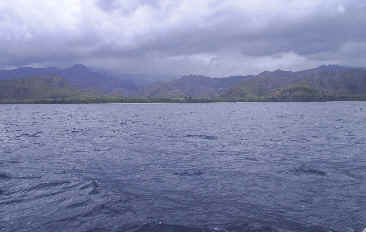 Wetar Island from the water.
Wetar Island from the water.
Unfortunately it was just a bit
too late to be able to see the reef clearly and we wouldn’t drive on top of
the reef and anchor there without being able to see. But the bottom went from no
show on the depth sounder to 40m to7m rapidly. We were faced with the choice of
continuing on through the night to Alor or anchoring on the reef slope in 28m.
We chose the reef slope, put out 75m, had a quiet night during which we checked
the depth and the GPS a lot, and
were able to retrieve our anchor the next day with just a little motoring from
the reverse direction. But we sure thanked our hydraulic anchor winch. Just
occasionally the reality of the isolation dawns. If something were to go wrong
no one would ever know about it.
Next morning we set off for
Labuan Air Panas (Hot Springs), written about in the cruising notes as a
“perfect anchorage” in 5m of crystal clear water over sand. We passed lots
of interesting looking villages on the way but found it hard to see how they
would land their boats – the shores are so exposed.
The anchorage was as described when we arrived around lunchtime on 27 August. And there was another western boat there – a yacht Cuchara which we had seen at Port Essington! Someone to speak English to....heaven.
No longer uninhabited, there is
now a group of five families who live in the bay, and seem to have a thriving
boat renovation business. They were working on two boats for East Timorese when
we arrived and last night another boat was towed in and landed on their beach.
They also keep water buffalo, goats and a horse and cut rattan.
We stayed in the bay three
nights and three days (including a visit to the neighbouring village which CMAP
calls Kalisana) and gradually as word went out that their were foreigners here
we began to get some visitors in dugout canoes with outriggers, some with
triangular sails of blue “Vietnamese suitcase” material. At first they were
asking for things (bensin – petrol – and solar – diesel ) and we gave one
some bensin and another some solar. Because we decided we shouldn’t encourage
begging (had long philosphical discussions about it actually) and because they
had a plentiful supply of coconuts, we asked for some in return.
Our trip to the settlement was
interesting – just five houses on stilts on the beach, a couple of water
buffalo sitting in pools of water nearby, surrounded by a small coconut
plantation. We looked at the boat building projects, sat under the trees with
the people, looked at our books, stamped the children’s hands with our smiley
stamp (causes a frenzy among kids in Indon. villages– use with care). These
people are immigrants from Sulawesi (Bugis) – have been there five years.
Have I mentioned before in this
ramble that immigration between islands in Indonesia seems to be huge. Everyone
seems to be from somewhere else. Many in Kisar were from Ambon and we have also
met some from East Timor. Christian churches are also prolific. Even in the tiny
and incredibly poor dusty town of Kalisana, the church, complete with steeple,
had a prominent position on the beachfront.
These people were very poor. Grateful for anything, including the burnt metal innards of a fuel filter, which Philip thought to save when he got rid of our rubbish, and empty beer cans. I traded five pegs for some yams we didn’t really want from a canoe that came to the boat, but they were just as happy to get R1,000 for 6 bananas (for R2000 we could have had the whole bunch.)
 Philip burning rubbish on the beach at Labuan Air Panas.
Philip burning rubbish on the beach at Labuan Air Panas.
31 August 2005
Kalabahi, Alor Island. We did an
overnighter here from Wetar. 110nm, so we could arrive at our landfall in
daylight. What a contrast! Our first big town. And our first Muslim one.
As we ran across the top of Alor
from a couple of miles out we could see villages with tin roof domes and blue
spires AS WELL AS cathedrals and churches. Every village has at least one of
each.
We are anchored in a small bay
near Kalabahi town. Cleared yesterday with a friendly and efficient
harbourmaster (who asked if he could bring his little boy to see the boat
today). Had our first Indonesian meal in a rumah makan (Nasi Campur – rice
with everything), kueh (cakes) from a market stall and wandered around the shops
(yes SHOPS!! – we haven’t seen any for so long.). And such interesting shops
too. Everything stores with timber, bike tubes, rifles displayed near the dress
materials, Bintang beer, exercise books, china etc etc etc. Lots of photocopy
shops, “Parramatta Road”, selling Suzuki motorcycles. And a mosque and a
church every mile. Very friendly and helpful people.
After our overnight trip we went
to bed at 7.30pm last night (a new time zone – it would have been 8.30pm at
Wetar) and this morning were woken at 4.30am with the call to prayer of, not
just one, but two mosques, followed by a cacophony of rooster calls. They are
still crowing as we sit in the cockpit in the cool 100m from shore, eating our
breakfast, watching (and hearing) the passing parade. And smelling the aroma of
cooking peanuts.
We can’t help reflecting that this is the most luxurious way to see Indonesia. We can experience everything in the flesh ashore, yet come home to our own bed and toilet and haven when the noise and the bustle and the “hey Mistah” gets too much. A bit like watching it on TV.
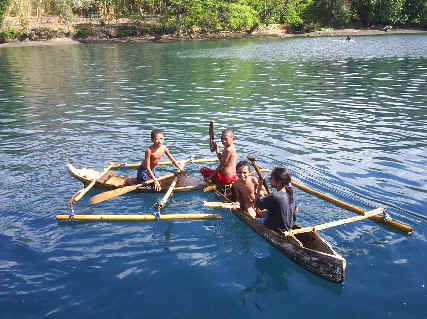

Kids playing at the anchorage at Kalabahi, Alor. Gado gado at our first warung. Philip pronounces it "great".
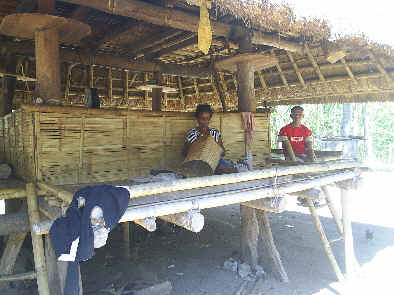 We took a tour and saw a "traditional village"
near Kalabahi.
We took a tour and saw a "traditional village"
near Kalabahi.
6 September 2005
En route to Lewoleba town,
Lomblen (Lembata) Island. We’re having the weather we came here to have. 8-10
kn NE, no sea, 29.9 degrees celsius, sunny. The islands we are passing are very
tall and dry but with breathtaking strips of fringing reef around them, white
beaches and coconut palms. We want to stop at all of them...but time marches on.
We have already eaten into 4 weeks of our cruising permit, which began on 10
August, so only have 2 months left to try to see as much more of Indonesia as we
can.
Kalabahi, a town of 170,000 and
the capital of Alor, turned out to be a nice piece of serendipity, and added up
to a near perfect anchorage. Sheltered and private in 15 m of gently shelving
water we had total calm for most of the day. A spring on shore where we could
get washing water and a place to tie the dinghy to a tree. About 2 kms from the
centre of town by bemo, motorbike or a 10 minute dinghy ride, with access to
good fresh food markets, shops, street stalls with yummy food, internet, diesel
and interesting touring. Friendly and efficient local officials from the
harbourmaster’s office and very friendly and helpful locals.
On the first afternoon we were
found by Achmad, the local tour guide, who came to the boat to sell us a tour
(or anything else he could organise). Left to our own devices, we would probably
not have had anything to do with him, thinking him a tout. But Warren and Robyn
on Cuchara organised a car hire and day tour for us all.
Alor has Christians and Muslims
but, according to Achmad (himself a Muslim), these religions came relatively
late to Alor and were overlayed on the native Animism. The clearest evidence of
that for me, was the payment of Moko drums (ancient bronze hourglass shaped
drums in limited numbers) as bride price by a prospective groom. Achmad said
that, as he could not afford Mokos for his wife, he owed her family their first
daughter when she is grown up.
Many of the villages on Alor are very traditional, with bamboo houses with tall high pitched thatched roofs, raised off the ground on stilts. Lovely and cool in the hot climate, they had a cooking fire in the middle inside a sort of bamboo playpen, with a verandah all around it and a ladder up into the roof for sleeping.
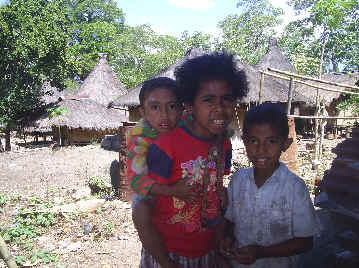
We fell in love with the
children who swam out to our boat in the afternoons and on Sunday when they
didn’t have to be at school: spunky little guys who’d grab a lump of banana
tree trunk or an empty plastic bottle to float with. They’d sometimes climb
onto the marlin board or hold on to the dinghy rope. We’d say in a serious
voice “Ma’af jangan naik” (please don’t get up) and they never did come
aboard. They loved it when we’d say “ready, set, GO!” and they’d all
jump in. We gave them bananas and wild oranges we’d been given at Kisar. We
were besieged with regular calls from the shore of “Hello Missus” and
“Hello Mistah” until they got to know us better, when it became “I love
you Missus”.
The internet place at the kantor daerah (the regional government office) was always an interesting excursion. By bemo, via the pasar Kedari (market), with Indonesian pop music vibrating through our bodies as we sat on seats on top of the speakers. The bemos had great names: Sniper, Doctor, Mother, Boy Band, Jazabel; Bad Boy, all red, with 4 12” bass speakers one metre apart. The “conductor” would hang out the door collecting the R1,500 (20c) as you got out and singing out “KedariKedariKedari” or KalabahiKalabahiKalabahi”.

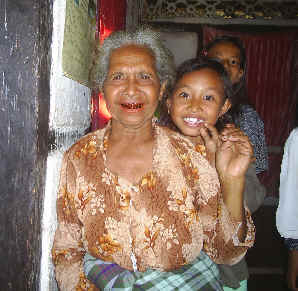 Grandma
betelnut.
Grandma
betelnut.
Bemo, "Sniper".
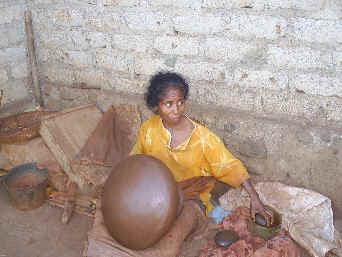 Pot maker, Alor Kecil village.
Pot maker, Alor Kecil village. 
The internet "cafe" at kantor daerah.
The internet itself was slow and
clunky, but you sat in an individual pine booth with pine desk and moulded
plastic chair. The other thing that made it slow was that the workers there
wanted to practise their English, so would come and sit in the booth with you.
At the market we were sought out by Agnes, who had very good English, a tall, rather elegant well groomed young woman. She helped us buy coconut oil for cooking and visited us at the boat. It turned out she and her husband were farmers. She had been at the market at 5am selling their chillies – 2-3 kg every two days for R60,000 (about $9). Originally from Flores, she had learned English as a housemaid for a rich Chinese family in Singapore, working three and a half years to help pay her brother’s university fees. Her husband, Joshua, had paid a bride price of 3 Moko drums and a gong. They were both avid Christians.
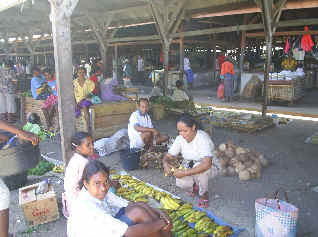
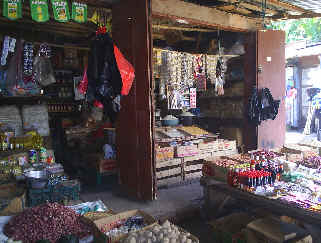
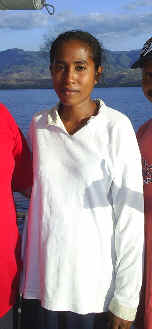
The markets. Agnes.
Over the course of our stay Achmad organised diesel, goat meat, laundry, propane gas and said he could get as many cashews as we wanted. I think he could have organised anything. He is also interested in “investors” in his 16,000sq m of ancestral land overlooking the beach at Alor Kecil, (well known to divers internationally according to our Indonesian dive sites book). He does not want to sell it but would allow usage on a “rent in advance” basis with a “MOU”. He says you could build a traditional house for $A500. Someone could set up a dive “resort” pretty easily. The dive sites are here but at the moment the only operators are at Kupang apparently.
9 September 2005
We have moved along pretty
quickly the last few days, aware that we have already used up a month of our 3
month CAIT (Indonesian cruising permit). We are still cruising in company with
Cuchara, though they are only going as far as Bali so they will probably travel
slower than us. Our next anchorage, Teluk Hading, our first on Flores Island,
promises excellent snorkelling.
After we left Alor we were ready
for a break from towns and spent our first night in Teluk Belurin (Belurin Bay)
on the north shore of Lembata (Lomblen) Island. As we motored past, the north
west tip of Pantar Island looked mouth watering, with glowing reefs and clear,
aquamarine water, and is reputed to have world class diving. But we wanted to
make more distance. We console ourselves that one day we are going to come back
to southern Maluku and eastern Nusa Tenggara and just spend months and months
here. I’m sure you could cruise here for years and never see the same
anchorage twice.
We are now having the weather we
came to South East Asia for – motorboat weather. Though if you can sail in 10
knots you could sail each afternoon. Each morning is pretty much calm with a
10kn NE seabreeze in the afternoons which drops off at night. We have clear
skies and 28 – 29 degrees. We haven’t had a weather forecast since we left
Australia but feel quite comfortable setting off for unknown places. Maybe
we’re in a fool’s paradise and will learn our lesson, but so far so good.
Teluk Belurin was a good
protected anchorage with clear water and quite nice snorkelling, Robyn on
Cuchara collected a large Cowrie and cone shell (both dead but in good
condition) lying on the sand between the coral heads. There is a large concrete
wharf in the corner of the bay but it seems to be in water too shallow for
access. That fact plus the unnaturally grid shaped lay out of the village on the
side of the hill nearby plus coral damage with new growth and sandy bottom makes
us suspect that the town suffered from the earthquake and tidal wave that
ravaged this area in 1992.
We motored to Lewoleba in Teluk
Leba Leba the next morning and had up to five knots of current against us as we
came through the Boling Strait. With no wind at all, there were whirlpools and
rapids. Would hate to experience it with 25 knots against the current.
Lewoleba is picture postcard picturesque. Flanked by two volcanoes at either end of the bay, the foreshore is lined with shanties on stilts over the water and coconut palms. In front of them are anchored lots of Indonesian boats – typically colourful. We saw a delightful canoe with lateen sail made entirely from old umbrellas, sewn together as patches. And why don’t Australians paint their boats lolly pink? – It looks great.
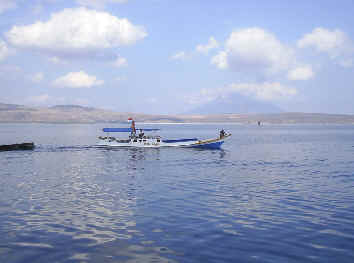

Our first volcano....and "motorboat weather". Sail made from old umbrellas.
We went ashore to a warung for
dinner of Gado gado and Nasi ayam (Chicken rice). As every warung serves exactly
the same menu it seems, we chose by the look of the food in the window and the
fact that they had a fan (Luxury.) There is a pecking order in food
establishments in Indonesia: Restoran (maybe in a “hotel”) is the highest (though the only one we’ve seen had
plastic tablecloth-covered tables with unshaded low wattage lightglobe hanging
over them), followed by Rumah Makan (Eating House in a real building), followed
by Warung (street stall/tent made of corrugated iron, bamboo, blue tarp with
stools and bench tables covered in lino or plastic) and mobile food carts (which
often seem to sell soup or sweet cakes and pancakes).
The next morning we shopped at the market, though we still have plenty of fresh vegetables from Darwin, thanks to our mobile fridge and also to eating ashore all the time in Kalabahi. I bought some lemon basil, some candlenuts, kecap manis (thick soy sauce sweetened with palm sugar) 4 huge avocadoes and half a kilo of raw peanuts. I am half way through making a Balinese dish with deep fried tempeh strips and deep fried peanuts.
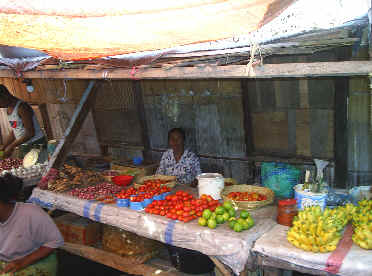
We have also discovered
Indonesian avocadoes. Sweet! I can understand now why they make milkshakes and
cakes out of them. We have several bottles of coconut water from the kelapa muda
(green coconut) in the fridge – a refreshing drink.
We weren’t really ready for
another town yet so we spent only one night at Lewoleba, but it’s a place
I’d like to go back to. I’d like to catch a bemo up the volcano to some of
the ikat weaving towns located there. We still haven’t managed to catch a
glimpse of someone actually weaving.
A thirty mile trip to Pulau Mas
(Serbete) Reef, where we anchored in 5 metres of sand, hanging back into ten.
Snorkelling near the boat was over scattered coral heads among sand. Clearly
there has been some big damage in the past (the earthquake/tidal wave?) but new
growth was lovely and unusual. I had never seen those purple, white and yellow
sea squirts before. No large fish but clouds of small colourful ones. I saw my
first Moray eel and a big Scorpionfish. And that was on the sand patch where we
anchored. The coral on the reef in 7-10 metres looked tantalising as we drove
over it en route to our anchorage.
I really hated to leave for Teluk Hading this morning. It was mirror calm, sunny, and the clear water glowed all the way to the bottom.
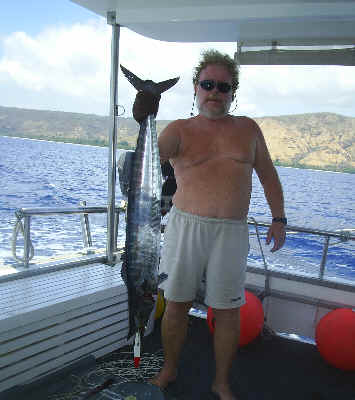 I don't know how I managed toforget to write about
this wahoo. It's the only fish we caught in SE Asia!
I don't know how I managed toforget to write about
this wahoo. It's the only fish we caught in SE Asia!
10 September
I think that is going to become
my catchcry in Indonesia: “I really hated leaving ....... this morning”. I
did. We stayed last night at a tiny baylet on the northern shore of Teluk Hading
(Bay) at the eastern end of Flores. The snorkelling on the point, which we swam
to from the boat, is as good as any I have done in Australia, apart from the
lack of big fish. Prodigious variety of corals in all colours, clouds of tiny
fluorescent fish and plenty of unusual, multi-coloured species as well. The
anchorages in Hading Bay glow. We’re sure you could spend weeks exploring just
Hading Bay.
But we came to a realisation
this morning that we have to speed up if we are to have any show of getting to
Thailand by Christmas. Three months isn’t anywhere near enough to spend in
Indonesia. If I were doing it again, I’d make it Christmas in Bali and spend
at least 6 months here.
We are now en route to Geliting, a “Seaworld Resort” just east of Maumere, the largest town on Flores. We figure we will probably find access to internet so I am hastily typing this up as we go along.
19 September 2005
Well we have covered a lot of
ground since I last put key to pixel. Philip is a bit happier – he was
starting to get a bit jumpy about not reaching Bali/Singapore/Phuket before our
Indonesian Cruising Permit/Visas/Period before Christmas (Pick any) ran out.
Sea World resort apparently
exists to show divers the reefs around the area (though they were apparently the
main focus of the earthquake and tidal wave that struck Flores in 1992). It is a
western/Balinese style place with bamboo thatched buildings, swept sand paths,
palms and gardens and open walled restaurant with ikat weavings on the walls. It
looks western owned (neat, laid back staff uniforms, no rubbish, western menu
– grilled fish steaks etc ) beach house with A/C, B’fast - $US25/night. I
love it.
After anchoring we immediately
set off for the big smoke, picked up on the side of the road by the shuttle bemo
from the rival resort down the road. Maumere was the first town in Indonesia
where we saw western tourists in any number (about a dozen) and was also our
first real internet cafe, COMTELNET (though with the same genuine Indonesian
connection speed).
Judging by the number of rumah
makan with menus in English and serving “Chinese Food”, there must have been
quite a few tourists here at some time. We tried one recommended by the internet
cafe, featuring a crucifix, pictures of Jesus and rosary beads as wall
decoration. Unfortunately it didn’t help the food, which was our worst meal
and most expensive in Indonesia so far (but, admittedly only R50,000 ($7)
including 2 longneck bottles of Bintang). The moral of the story: don’t take
dining tips from internet cafes.
Maumere was an interesting
shopping experience. I’m still regretting not buying a lovely naturally dyed
ikat I saw at the markets. The rest of the markets seemed to be mostly shoe
stalls (why? – a mystery). I was most taken with the electrical stores selling
TVs, DVDs, CD players etc with big displays of petrol generators in front.
Indonesia is a good lesson in
what taxes buy. Or, rather, what no taxes don’t buy: ie roads, footpaths,
electricity, street lights, rubbish collection, sewerage and drainage, public
education. Private enterprise is the name of the game, but of course each
individual business won’t provide a decent path or road to it etc. You need
government for that. And Indonesia has five levels of it!!! (But not enough
taxes to cover both graft and public amenities.)
From Maumere we bay-hopped along the north coast of Flores, eventually anchoring in Teluk Bari, where we met La Bonnieto Borneo Malakiano (Bonny). Having good English is such an advantage to people in small villages and also to visitors like us. We weren’t really ready for more people yet, but Bonny was charming and interesting and invited us to his home and the local school in the village of Bari. (Where we introduced those poor Bingo-deprived kids to the world’s most popular game cunningly disguised as a good way to practise English numbers.)
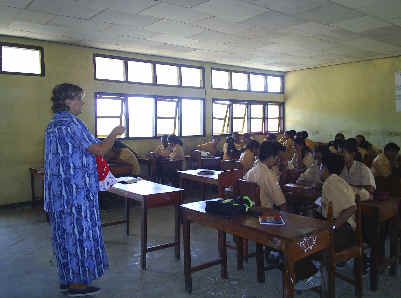
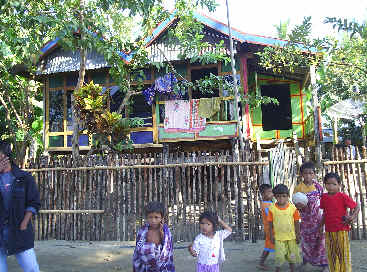
Bari school. Bonny's family's house.
We gathered that Bonny’s
family was well to do in the town. His father had financed his sons into a boat
to take his bananas and other produce to market in Bima on Sumbawa Island, a
motorbike to take their fish to Ruteng and was paying university fees for Bonny.
La Bonnieto was home on holidays
from studying English at university in Makassar, Sulawesi. He had attended the
Tourism highschool in Labhuan Bajo before trying to be a guide (for R100,000
($15) per month, accommodation not included), then a policeman in Kupang
(R25,000,000 bribe to the interviewing officer to get a job too expensive) and
now was a student. He was travelling to Labhuanbajo at the end of the week to
catch the Pelni ferry back to Sulawesi.
As Labhuan Bajo was only five hours away, we invited him to travel with us and then hired him to take us on a day tour when we got there. La Bonnieto told us lots of interesting things on the way.
For instance, we had noticed how
much mobility there is in Indonesia. Isolated camps and villages seem to have
sprung up around the edges of the islands against steep, barren and forbidding
backdrops. We wondered how they came to be there and how they grow – since
they seem to be isolated from each other and everything else.
La Bonnieto’s grandparents
left Sulawesi when the Japanese were there during the war. They started the
village at Bari. When a new person wants to join the village, they are assessed
by the group of longstanding people and if allowed to stay, they are allotted a
piece of land. The traditional price is a chicken, an egg and some drink.
He also explained that there are five levels of government in Indonesia:
1. Village. A group of the longstanding members of the community choose 2-3 candidates for Kepala Desa (village head man), who is then voted for by the men of the village. The Kepala Desa must be smart because he has to put funding proposals to the next ;level of government.
2. District. Several villages choose a representative for the district (apparently by election)
3. Regency. Several districts vote for their Regency representative (who come together as a DPR)
4. Province. The Regencies select Provincial representatives who make up the Dewarin (Council) Perwakilan (Representative) Rakyat (People’s) DPR of Indonesia
5.
Country. And there is also an MPR who selects the cabinet –
possibly with some appointed people
I have
absolutely no idea how this all happens. But this probably explains why there
are so many government offices in every town and village. Even Letti had maybe a
dozen substantial painted concrete government offices with signs, gates etc And
it is like that everywhere
Our “tour” in Labhuan Bajo
was sad. We visited a cave with stalagtites and stalagmites, guided by students
from the Tourism highschool (and La Bonnieto cast as the conquering hero
returned to town with rich westerners in tow). This is Labhuan Bajo’s one
tourist attraction, apart from being a jumping off point for boats to Komodo.
While the cave was mildly
diverting, the young guides were so keen to practise English and their spiels,
to promote their local attraction and Indonesia and to generally do a good job,
we were delighted by them.
Apart from its paucity of
tourist sites, Labhuan Bajo was an interesting small port town. The harbour was
full of colourful Indonesian boats – the most we’ve seen in one place.
It’s also a stop for the Perentis freighters and Pelni ferry/cruise ships.
Here people can charter boats to Komodo and Rinca to see the dragons and there
is plenty of evidence that backpackers pass this way. I am talking here of the
losmen/ bars serving distant copies of western food and buzzing with
English-starved travellers.
We’d rather eat Bakso – a
delicious concoction of broth with meatballs, noodles and roasted peanuts.
We had fun buying produce and sarongs at the market (yes, Philip has “gone native”) with the help of a young attractive English speaking woman, Rit, who attached herself to us. Over coffee, it turned out that Rit is studying in Ruteng to be a nun and will be sent to the Philippines when she finishes. We were quite surprised because Rit looked so normal, including dressing in tightish jeans and v-neck Tshirt. Catholicism is big in Flores.

Have I mentioned about people
walking around usually quite unembarrassed, with white (or sometimes coloured)
paste on their faces? Like a neatly painted on mud pack. We first saw it at
Kalabahi, but have now encountered it many places, on boys as well as girls, in
villages as well as towns. Not sure why but we’ve narrowed it down to 2
possibilities: sun protection (a young fellow said that was why he was wearing
it but he was embarrassed and washed it off immediately) or skin whitener – we
have seen jars of this for sale, babies having powder put on their faces and
people have commented that light skin is more beautiful than dark skin. People
are very wary of getting sunburnt and wear heavy long sleeved clothing even in
the heat, to protect themselves.
We motored direct to Rinca
Island from Labhuan Bajo where we did a late afternoon 5km walk with a ranger
through the Komodo National Park. We saw many large (3m) dragons, actually large
carnivorous monitor lizards who can run at 18km/hr. Most were sunning themselves
or mooching around the water holes eyeing off the buffaloes. The buffaloes seem
to be a peace loving, grass grazing lot who’d be quite happy to eat and wallow
but who are numero uno for the lizards to kill and eat. The utterly rotten thing
is, the bastard reptiles don’t kill them but just take a small bite out of the
buffaloes, which turns septic over a month and kills them. Then the dragons eat
them. What a way to go.
While walking we encountered a group of researchers from Java who were tagging and measuring the dragons. A “volunteer from the village” had to entice the dragon with rotten meat on a string. When it got interested he had to run off with the dragon hot on his heels so the researchers could lasso it, sit on it, tie its arms behind its back, tape its mouth and then finally measure and tag it. We got to watch and photograph all this as our guide joined in. As well as pat the dragon while he was being pinned down. Imagine a tour in Australia letting you wander a few feet from dangerous creatures. But don’t like our chances here of suing for negligence if we got eaten. As the sun set over the barren landscape we felt satisfied we’d had our $A15 of monkeys, deer, buffaloes and wild pigs.
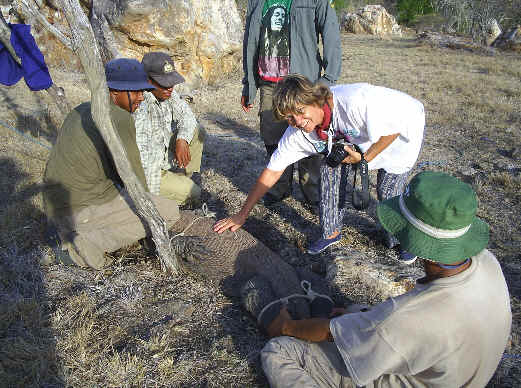
Before we left the next day we
were offered hundreds of strings of pearls and carvings by a local hawker canoe.
This is another first. As we head west we are getting closer to Tourism
Indonesia (if it still exists).
We can confirm finally that the
snorkelling is world class in this neck of the woods. Our experience at Banta
Island was bagus! (and we sincerely believe the reports that Komodo and Rinca
are similar). There are clear aquamarine water, fields of corals, hundreds of
varieties, clouds of many different types of small fish, just a short swim from
the boat – and even large fish to keep Philip happy. I also picked up some
beautiful shells, abalones, clams, cones and large cowries, though not keeping
live ones. Even though we were told in Australia about Indonesia’s pristine
waters and excellent diving, we couldn’t quite believe it.
Getting to Banta we also
experienced Indonesia’s fierce currents, going through white water before we
entered the bay. No problem, except that we were towing our dinghy, as we had
become accustomed to doing across the top of Flores.
Some dolphin fishermen resting
in the bay until the current eased, told us when to leave for Wera Bay on the
north coast of Sumbawa. None of them have watches – they tell the time by the
height of the sun - and I was reminded of “rubber time” – a half
disparaging term applied to Indonesians’ propensity for being late (or early).
Most people don’t have watches.
We have been able to communicate
via HF with Val and Graham on Silver Heels and are slowly catching them up –
they are now only about 40 miles ahead of us. They travelled from Darwin to
Kupang; Kupang to Rinca, Rinca to Sumbawa in company with Helmut and Louisa on
Snowgoose. Helmut and Louisa are a fun, fastidious Swiss/Portuguese couple who
don’t eat garlic. Apparently they managed to find a steak in Kupang, but we
wonder how different their experiences will be from ours. They are not going to
Bali, whereas we intend to base ourselves there for maybe two weeks and to do
some land exploration to central Bali and Java. We hope to meet up with them
beforehand in Lombok.
Behind us are Cuchara, who have
now decided to go to Malaysia and Thailand for health reasons, and Argos,
another motorboat from Lake Macquarie on a circumnavigation. Philip suggests
when we all get together we have a traditional Australian motorboat “raft-up
and piss-up” to celebrate.
This morning we left Wera Bay on NE Sumbawa and are en route to Kilo 30 – 40 nm east. The village in Wera Bay was fascinating. 40 boats on the beach in the process of being built. Several of them were 20 metres long, each under its own thatch roofed bamboo shed, propped with trees (growing) and tree trunks (cut). We had a look over one of them. Complete with hull, deck, cabin, engine and running gear, it will cost R200,000,000 ($AU30,000) and take 1 year to build.When finished, they are pulled into the water by tractor.
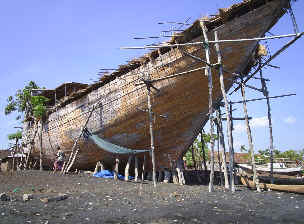

We have seen some gorgeous
western-style Indonesian charter boats around this area – some from Bali –
fitted out with oiled wood and deck chairs and crews in matching polo shirts –
which do the diving circuit. Some have 12 crew to 2 guests. You’d need to get
them fitted out in Thailand or somewhere, though. The Indonesian woodwork, while
ingenious, given the lack of tools, and strong, is a bit agricultural.
Wera Bay beach also sported the most extensive assortment of poos, human and otherwise, that we’ve encountered in Indonesia. It’s common to see bare bottoms taking care of business in the morning, but usually people seem to be careful that the tide washes it away. Maybe the Wera Beachies are extroverts.
25 September 2005
A few days ago, at Labuan Badas,
the harbour for the large town of Sumbawa Besar on Sumbawa Island, we had our
first case of a corrupt official trying to intimidate us with power. The harbour
was a very good anchorage and we had caught up with Silver Heels and Snowgoose,
who had arrived the previous day.
Things were looking pretty good
and we were looking forward to a drink once we were settled, when the local
policeman whistled us to pick him up in the dinghy. (At this point I should say
that our papers are all in order and there is no need for us to check in with
officials in towns, though we mostly do it as a courtesy if they come to the
boat.) At first he was pleasant enough, until we asked about buying fuel there.
He wanted to sell it to us but said we had to do it immediately. We weren’t
keen on that and said we’d do it tomorrow.
To cut a long story short, he insisted Philip accompany him to the police station, where they copied, word for word, the “clearance” we had got from the cops at Letti Island. Then they asked for a R150,000 bribe. $20 (AU) isn’t much but it’s a ludicrous amount here. Also we had been told by Val and Graham that other cops and Immigration had got hold of them and there had been more bribes etc to pay. They were about to warn us to turn straight around and leave, when we picked up the cop.
By this stage it was dark and
Philip was furious. These guys offered nothing – just wanted money. He handed
over R20,000 and stomped off. Of course he felt very vulnerable as he walked
back to the boat in the dark and rued not bargaining with them and giving them
fifty so they would save face. Anyway, we had a sleepless night and decided to
leave first thing next morning, thoughts of “planted” guns or drugs on our
minds.
We were just getting out of sight of Sumbawa on a mirror calm morning when we could see a fast boat following us. As they got closer we could see that there was a guy with a machine gun on the front. Closer and closer they came until the nose of their large fibreglass launch was just off our port quarter. “Selamat pagi” says Philip. “Ada bir?” comes the reply. Two young navy guys out for a jaunt in the navy speedboat asking for beer. We threw them a pepsi and a coffee creaming soda, took their photo, and breathed a big sigh of relief as they sped off.
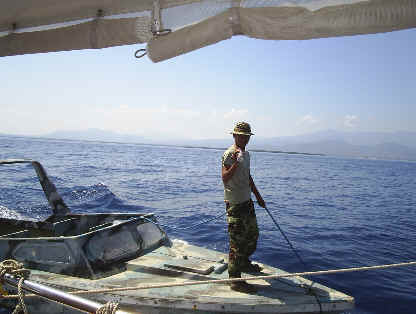
This part of Indonesia is a
different part of the world from Eastern Indonesia.
We had a delightful stop on the
north eastern corner of Lombok, where we met some local villagers and reassured
ourselves that people here are honest and friendly like those we had met on
other islands. A local fisherman went by yesterday and called out “Good
morning sir” (Now there’s a first.)
Now we are en route to Gili Air,
off the NW coast of Lombok, entering real tourist territory and only a hop step
and a jump from Bali. There are lots of interesting things to see ashore –
Lombok appears to be much more developed than anywhere we have been before.
Apparently many new fish farms, probably just as well because the seas have just
about been fished dry we think. Also telegraph poles and new housing
developments. And all backed by a goodly few volcanoes, including Mt Rinjani..
2 October 2005
We are headed to Bali having got
news this morning that 6 bombs went off there last night. We feel so sorry for
the Indonesian people – not just the Balinese. The tourist part of their
economy has been wrecked by the first bomb, the tidal wave and then the Corby
thing and now this. The Indonesians really get a bad wrap – because of some of
their past leaders and officials. (Imagine the effect our strutting Mr Howard,
simpering Mr Downer and their mob is having on our image as Australians.)
You’ll be pleased to know though, that Philip has taken on the role of roving
ambassador of Australia. And as a result we feel we have many friends here. This
morning we had lots of text messages from Indonesians we told we were going to
Bali, hoping we are OK.
Almost a week anchored at Teluk Nara on the NW corner of Lombok just flew by. The first day we took a day tour of the sights in an air conditioned minibus with a few other boaties. That sort of gave us the lie of the land, - we were anchored about 20kms out of the capital, Mataram. Another day we rented a bemo to go to the markets, internet, supermarket etc in town. And on a third day we hired a car and driver to take the coast road to Senggigi and the craft markets. All were arranged by Mohamad and Abdul, who would be the moguls of Teluk Nara if only the tourists would come back.
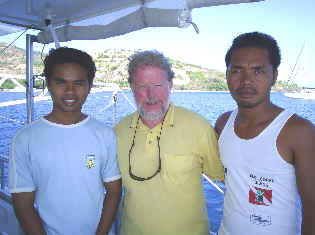
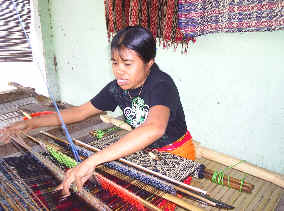
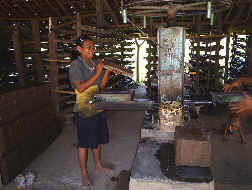
Mohamed and Abdul with Philip. Weaver using backstrap loom. Making bricks (Note baby on right.)
Lombok is on the border of the “Wallace Line”, where the scenery changes from Australian style dry, barren, eucalyptic to green, lush, rain forest and rice paddies. It’s lovely to see some green.
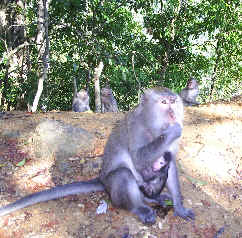
Senggigi, the tourist mecca of Lombok (a little like a young Noosa or Port Douglas) is a tragedy. Beautiful hotels and guesthouses just abandoned, the place clearly (even to us who’ve never been there before) a shadow of its former self. Having said that, the bays around Senggigi are beautiful, with clear water over coral and sand and coconut palm lined beaches. And much of it up for sale.
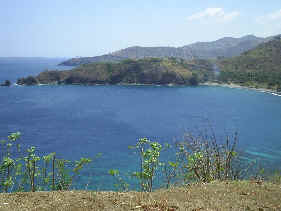
From our “research”, we think Lombok is probably the source of plenty of “Balinese” style stuff in Australia. The system here seems to be not to have a factory making stuff but a whole village. So you have a bamboo furniture village, a roof thatch village, a brick village, a pottery village etc. If I’d had anywhere to send a container load of goodies, believe me I could have managed it. I could spend weeks here ferreting out exports to Oz or just buying lovely things. As it was we only bought a few things – some timber bowls with woven edging, batik painting, another volcanic rock “mortar and pestle”.
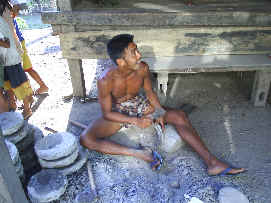
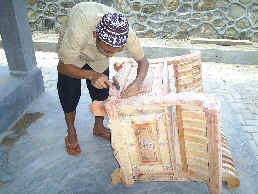

Mortar and pestle carved from volcanic rock. Chairs being inlaid with mother of pearl. Chairs inlaid with mother of pearl after staining.
I also tried out the medical
system here on our second last day. I had a fever of 102 with lots of symtoms of
malaria (or so I thought) so went to have a malaria test, which are commonly
available here. Mohamad brought his motorbike and a friend on another one and
they took us to the hospital in the nearby town of Pemenang. The hospital
(clinic) was very clean, white tiled, with the same glass fronted stainless
steel cupboard that I’ve seen in Australia, with cotton wool, dishes and
stethoscopes and stuff in it. The syringes were prepackaged and of the same
brand as I’d brought from Australia – the nurses were very keen to compare.
The doctor spoke some English and the results of the test were available in an
hour while we waited.
Being with Indonesians for any length of time makes you realise how much (and how often) westerners eat. For instance, we wanted to take Mohamad and his friend to have coffee while we waited for the test, but they preferred to wait on the wooden benches outside the hospital. At other times we’d offer cold drinks or coffee or tea, which they would accept, but always only drink a little and eat even less. We’ve noticed it with all the Indonesians who have come to the boat. Abdul told us that their normal routine is gado gado or compressed sago or rice cakes for breakfast, small snacks through the day and at night they might have a coffee and a piece of fruit.
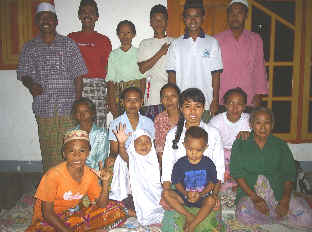

Abdul and Mohamed's family. Topping up the tanks by jerry can!!
4 October 2005
Our first day in Bali went well.
The dreaded check in to Indonesia is done and not now hanging over our heads.
Although we have had lots of officials all over the boat and all sorts of
weaponry, we had not yet had our visas activated by Immigration or been
inspected for smuggling by Customs.
Those who’d checked in at
Kupang reported requests for bribes, bottles of whiskey, wine etc. One friend
had had his bottle of Glen Fiddich taken. The rules for a boat are that you have
a duty free allowance per person, which you may bring into the country and drink
anywhere and you have “ships stores” which are for consumption on the boat
(which is a piece of Australia). On big boats ships stores are put in a bond
locker with a paper seal which is checked by Customs at departure to ensure you
have not dipped into them. Usually on yachts they don’t worry about this.
We used an agent to do the paperwork and he had the 4 officials rounded up to come with him at 10am. Everybody accepted cups of coffee or coke, except one immigration man who wanted wine. After chortling our best shop laugh, we established that he did indeed want a glass of wine, which we gave him, from our best chateau de cardboard cabernet-merlot. (When his mate decided he’d like one too, we poured half a glass from the first guy’s glass, which he didn’t seem to take as a slight).

After the paperwork was dealt
with, the Customs guys then started randomly opening cupboards and looking
inside, looking in the engine room and the tank room etc. They then wanted a
“souvenir” from Australia, a bottle of wine for one and a bottle of coke for
the other. The funny thing was, we only had cask wine on view and to give him
just one bottle would have meant revealing that we had some bottled wine. So we
decanted some from the cask into a bottle and gave him that, which he was happy
with. His wine-drinking Immigration mates got two cans of Aussie beer. Whew!!
When that was over we went into
town and organised flights to Yogyakarta to see Borobudur and Prambenan and a
car to take us around Bali. A very productive day.
11 October 2005
As we motor up the coast of Bali with three knots of current against us, we’re having a bit of a chuckle about everyone’s war stories about Bali’s persistent hawkers. We were lucky. We only ended up with a bunch of pencils we didn’t want. Phil and Margaret on Argos, the other motor boat we are currently travelling with, are much more kind hearted than us and now own a carved box of chopsticks and several sarongs as well as the pencils. The hawkers in certain places – notably the road to and from Ubud – are masters of:
1. getting their arms in the car even while moving,
2. wringing guilt out of overfed tourists
3.
never giving up.
We learnt to cross the road
while we were in Yogyakarta and find it works in Bali too. The traffic never
stops, so you step boldly out in front of it while waving in a downwards motion
with your right hand. And they all stop...well the ones coming straight at you
do – the ones before and aft keep going until you move in front of them.
On the other hand, maybe it was
because they didn’t want to run over some of the few tourists left in Bali
after the bomb. Those poor people. Their economy wrecked because of a couple of
loonies out to punish western ways. Timed to coincide with the AFL grand final,
which many Aussies follow here? Or maybe Yodoyono’s visit with Mr Bush? We
can’t help thinking they want to punish the Hindu Balinese as well as the
westerners...and they are certainly doing that. But they’re inadvertently
punishing all of Indonesia as well, which has enough bad press without that.
However we can report that Bali is safe, quiet and you wouldn’t even know
there had been a bomb. It wouldn’t stop me coming here.
Incidentally, we met up
yesterday with another boat from Australia who we knew in Darwin. They were
thinking of not going to Kumai in Kalimantan because there are travel warnings
on our government’s foreign affairs website. Remember, everyone, this (travel
warnings) site was set up after the first Bali bombing when the government got a
serve for not warning people there had been intelligence about it. The site is
an arse covering exercise (plus we get to be a bit more like the Yanks, who had
one first.) Sure you may get killed in a bomb in Bali (or London, or New York),
but I’ll bet the odds of getting killed in a car crash in Australia are
greater!!
Australian people are being
manipulated by our government and media into thinking the world is no longer
safe. Poor people in places like Indonesia depend on tourism for a large chunk
of their economy. It’s a great outcome for terrorism – they only need three
people and a lame dog to keep the world in its place. And in the meantime
Australia plays cowboys with Mr Bush in Iraq. #@%#*!! Thank heavens we don’t
get news very often.
Just one final thing before I end the tirade...we can really see why Islam might want to resist western influence. From what we’ve seen in Indonesia at least, it seems to foster strong families and communities, spiritual strength in adversity, cooperative values and honest behaviour.
Not our cup of tea at all –
give me hedonism and booze any day!
Now where was I before I
interrupted myself?
Ubud was lovely. Lush and clean and artfully laid out with winding cobbled streets and “Double Bay” shops interspersed with galleries and handcraft stalls. The King’s house was a highlight. A series of open pavilions with carved gilt uprights, chandeliers and bamboo and furnished with European antiques. And set in beautiful gardens. The descendents of the Balinese kings still live there (you could see their thongs lined up in the shoe racks on the verandahs) and although not recognised by the government, sovereignty is still passed along the line.

We were in Ubud during Galungan – “Hindu Christmas” – and it was full of men in brocade sarongs and women with coloured lace kabayas and silk sarongs walking down the street with baskets of flower petals and food offerings on their heads, like Asian fairy princesses. Once the gods have had a go at the food they offer it around to others and gawkers just like us. Nearly every house has a tall bamboo pole with little decorations made of folded split palm leaves dangling from them. And every temple’s stone guard dogs are dressed in black and white check cloths (to ward off evil spirits?)
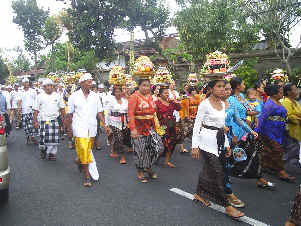

We stopped in at the Casa Luna
for coffee and found the decor as well as the food was “fusion” – open
thatched pavillion but with hot pink painted dividing screens. That’s how
I’m going to build my house on Russell Island (Think Redland Shire Council
will come to the party?). Apparently you don’t need any approval whatsoever to
build a house here, which probably partly accounts for the innovation and also
for the jerry builtness of many.
Bali Marina is as shabby as its reputation. Actually “contemptuous” probably better describes its attitude to customer facilities (not the staff, who were as charming as the people everywhere else in Indonesia). Not only are the fingers sunken and wobbly, bare wires at the power poles, dirty showers with cold water, undrinkable water supply etc etc, but they charge incredibly high prices for everything. Owned by a wicked accountant and not run at all. But then, it is the only marina in Indonesia with very poor anchoring options. We went there purely to leave the boat while we were in Java. Anyone want to invest in a marina in Labuanbajo – a perfect harbour at the centre of the yachting milk run?


While we have been in Indonesia
they have been having an oil fuel crisis. They have recently become a nett
importer instead of exporter and are under pressure to put their domestic fuel
prices up to parity with world fuel prices. This led to speculation that prices
would rise which led to hoarding, which led to shortages. Then there was
legislation to stop visitors buying diesel in jerry cans from service stations
at the local (ie subsidised) price of R2100. (But as there are mostly no fuel
docks that is the only way yachts can get fuel). Meanwhile we were blithely
cruising along, blissfully unaware.
Although we figured we had just
enough to get to Singapore, we had started keeping our eye out to buy some from
Sumbawa onwards. We had started hearing reports that you had to wait a few days
to get some and that there was a limit. So at Lombok we bought some (twice- they
could only get 400l per day and were doling it out to all the yachts in the bay)
from the beach from Mohamad and Abdul. 370 litres siphoned from a drum into an
array of different sized jerry cans. This was R3,000/l (45c/l) to cover the
price of the diesel, the bribe to be able to get it in a drum and
transportation. Pretty good value.
We kicked ourselves for not
having the camera to record the guy siphoning it by mouth, copping a mouthful,
then having a cigarette to get rid of the taste; the chook hopping around on top
of the drum and the casual wiping of sand from the top of the jerrys with an old
rag. We really blessed our baja filter and the duel filters to the day tank
which allows us to quarantine each separate tank.
We figured we could get some in
Bali, albeit at R5,000. When we got to Bali, though, it was a different story.
The marina had no fuel, the domestic price had risen to R4,500 and the marina
scuttlebut was that the marina was going to charge R12,000 if they ever got any.
We flew to Yogyakarta to let it sort itself out while we were away.
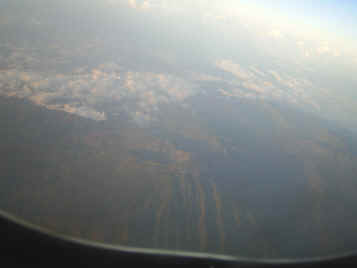
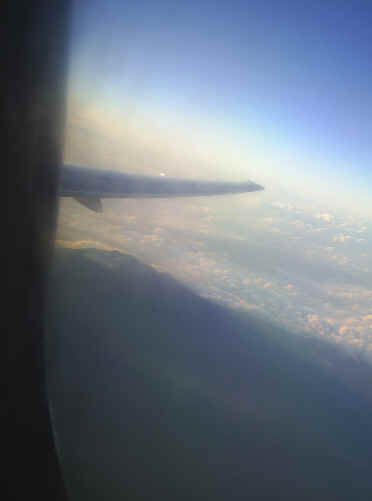
We were particularly impressed
with the Prambanan complex of Hindu temples near Yogya. Built in the ninth
century, around the same time as Buddhist Borobodur, the stone carving is very
detailed and three dimensional and tells the story of the Ramayana as you go
around the main temple. At both places, there are photos of when they were
unearthed in the early 1800’s after being covered in volcanic ash and then
jungle less than 200 years after they were built. Both looked not much more than
a pile of rocks before reconstruction. If I were to go there again, I would go
at 6.00am when it opens or sunset. On Thursday evenings there is a dance and
gamelan performance in a wonderful open air pavilion up high, which would also
be magnificent.
In Yogyakarta we stayed in the old city, now catering mainly to backpackers, with interesting houses, shops, losmen and restaurants in “gangs” – tiny streets, only as wide as a footpath where they even have pint sized vehicles to get through the streets and deliver things.
This was our first experience in Indonesia of “backpacker
touring culture” by which I mean a profusion of cheap entertainment, bars,
internet cafes, food places with part western menus and treats as well as laid
back decor to appeal to westerners (eg lamp shades and subdued lighting instead
of bare bulbs; ethnic tablecloths instead of plastic, tiny, interesting
bookshops, live music, food with cheese in it and cheap beer!).
We visited Sonobudoyo Museum that night to see a wayang (shadow puppet) show with gamelan orchestra accompaniment. It was very atmospheric. We could move around in front or behind the screen. Apparently the kings and important people (and men) sat on the lit side where the puppets and puppeteer can be seen and the women and other unimportant people sat on the shadow side. This is because, without seeing the colours of the puppets you can’t understand what’s going on. The show we saw was only one episode in the Rahwana story (2 hours). A whole show goes for about ten hours with one puppeteer doing all the puppets, narrative and sound effects. He even has to keep tapping a bell with a donger held between his toes while cross legged. What a guy! We enjoyed it very much but only managed an hour.
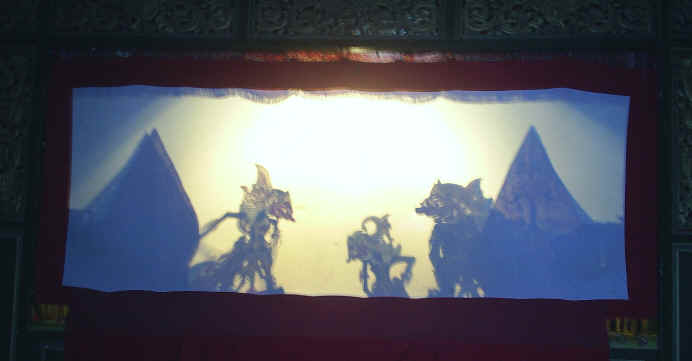
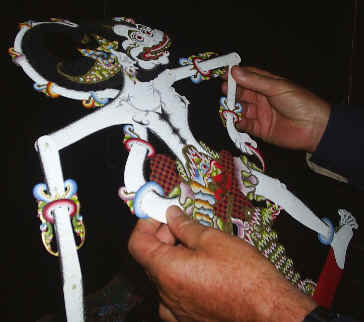
The day after we got back to
Bali we heard diesel was available at R6,000 – and from a bowser. We took on
1350 litres and Argos took the rest. Bali marina was out of fuel again. From now
on, we’ll keep topping up with small amounts. We are still running on our
Australian water – have about a third of a tank and have, so far, not had to
resort to salt water. Still no rain.
13 October 2005
Last night we anchored at Lovina
Beach on the north coast of Bali. This is a pretty and sheltered spot with
coconut palms and large trees on the beach, beneath which are all kinds of
interesting eating places and internet cafes. (Yes, definitely evidence of
backpacker activity). We got all fired up to rent a car and see the top side of
Bali, but realised time is marching on and we really do want to go up the river
in Kalimantan to see the Orangutans.
Lovina Beach takes the “Most
Active Hawkers” prize for their efforts before we had even got out of the
dinghy. They were voracious but at the same time apologetic for trying to sell
to us because there were no other tourists. I felt a bit sorry for them really,
but escaped unscathed. (Phil on “Argos” got away with just buying a couple
of beautifully made notebooks but would have been married to one of the
attractive young women if we hadn’t rescued him. You can’t afford to let
them separate you or you’re dead meat.).
Hawkers aside, Lovina looked an
interesting spot and we think it could be a real alternative to Benoa to leave
the boat during the day to tour the island by rent a car. That way you can see
what you want to see without having to go where your guide/driver wants to take
you.
We are trying as far as possible
to day hop now we are in the northern half of Indonesia. The waters here are
reputed to be full of debris, fish traps and nets and big ships and other craft
and we don’t want to encounter them at night. The wind and seas are being very
kind but the currents are not, with 1-2 knots against us for half of the day.
And so it was a 6am start this
morning en route for Raas Island just off the coast of Java.
17 October 2005
Raas was a good anchorage
surrounded by coral reef.
As soon as the anchor was down a
boat load of “police” kids (one of them had an ID that looked like it had
been printed on someone’s coloured inkjet printer) came over to tell us that
we were in a conservation area and we needed to pay R200,000 to anchor there. Or
we think that’s what they said – we only understood the money bit but played
dumb as to the amount. We said “No. No. We’ve been in Indonesia two months
and we know we don’t have to pay for anchoring”. He tried to translate
R200,000 and came up with “Two thousand”. “Dua ribu?” we asked.
Eventually they said “Well what about some money for diesel?” Philip gave
them R20,000 ($3) and they went off happily to visit Argos, inviting us to visit
the village.
Meanwhile Philip radioed Argos
and told them to just give them R20,000. Apparently they couldn’t make
themselves understood over there at all and were about to leave empty handed
when Phil on Argos said “My friend said I have to give you R20,000”. That
made them really happy and off they went. Quite a good humoured exchange, as
most of our bribe negotiations have been.
We didn’t get off the boat and
didn’t leave until the afternoon because, in the morning, there was strong
wind from the direction we wanted to go. So we ended up doing an overnighter to
Bawean Island in the Java Sea, the closest jumping off point to Kumai (Tanjung
Putih) in Kalimantan..
Bawean was a place we had heard about as a delightful place and, probably inevitably, were a little disappointed with it. It is certainly beautiful with lush volcanic hills, and palms ashore. And the boats are gorgeous, almost Arabic in shape with multicoloured psychodelic designs on their hulls. We stayed a couple of nights, eating at one of the warungs in the small village. The people were friendly, though there seemed to be quite a lot of desultory teenagers lying about making jokes at our expense or roaring along the little street on their motorbikes. Between them the several mosques were going almost 24 hours a day, rather than the usual five times. Don’t know whether it had anything to do with the fact that we are right in the middle of Ramadan.
We have to admire the devotion
of the Muslims during Ramadan. They cannot eat or drink (or smoke) after 3.00am,
until 5.45pm. Yet they have to go to work as usual. The mosque seems to be
calling them to prayer constantly. We wonder when they sleep. This goes on for a
month.
The weather seems to be suddenly
changing as we go north – and in fact October is supposed to be the “transition period” before the rainy season in
Indonesia (the dry season in Thailand). We have filled up our water tanks (the
first water since Darwin) in rain squalls since we left Bali. And the sky is
constantly cloudy with squalls around and sometimes lightening.
We are jaded and tired. Too much of a good thing. The sights and sounds and people and quirky things that happen here in Indonesia as well as all the just plain mindblowingly awesome stuff to do and see here has kept us busy experiencing as much as we can in our short time here. I’m looking forward to a boring anchorage with bad weather and just curling up with a newspaper. Or maybe a week at a swish Singapore marina with power and water and a swimming pool.
25 October 2005
From Bawean Island we crossed
the Java Sea to Tanjung Putih in Kalimantan, where we travelled 15 miles upriver
to Kumai. The aim of this major detour from coastal cruising was to visit the
Camp Leakey Orangutan Rehabilitation Centre in Tanjung Putih National Park.
(Although this has been on my
Indonesian itinerary for some years, Philip was less than enthused about seeing
“a bunch of monkeys”). So, where do I start?
First, Kumai was a surprise.
No-one goes to Kumai to see Kumai. The orangutans are the attraction. But we
really liked the township (and its “big town”, Pangkalanbun, 20 kms away).
It’s a port community of unpainted stilt houses over the water and ramshackle
wharves fronting the river, which is visited by Pelni passenger ships and large
wooden pinisi freighters. Many small brightly painted seagoing fishing boats and
river boats are moored along the banks. It is also home to a fleet of tugs that
tow huge (unlit) barges filled with palm oil from Kalimantan to Java and filled
with gravel from Java to Kalimantan. The town is basically one long main street
running parallel to the river and has 13(!!) mosques and a large, fantastically
colourful market, with the best seafood we’ve seen in Indonesia. Though
don’t ask where they get the fish because we haven’t sighted or caught one
since before Flores.
We spent a day doing our
business in Pangkalanbun, including spending an hour in the internet cafe trying
to retrieve emails and check our bank, before the power went off mid stride.
This part of the world has lots of rain and thunderstorms. So part of the day we
slopped through puddles and huddled under blue tarp awnings which the shops and
street stalls hurriedly lower to protect their merchandise. The footpaths are
raised about eighteen inches above the road, apparently with drains below.
We had been told not to miss the Iduna Cafe and bakery. This turned out to be a little piece of Newtown cafe culture jammed between the electrical, hardware, rope and plastics shops that seem to line every Indonesian town street. White walls with feature hot pink ones, minimalist artwork, recessed ceilings with concealed lighting, timber floors and cafe furniture. It was a shock. Everyone in Indonesia seems to eat out a lot of the time but “decor” and “ambience” are unknown concepts.
At 8 am next morning we boarded
our boat for our two day “African Queen” style expedition up the Sekonyer
river into the jungle to see the orangutans. Four of us shared a klotok
(Indonesian river boat named after its sound), leaving a “boat guard” on
each boat.
The lower reaches of the river
were brown and muddy, the result of illegal gold mining further up the river.
Speedboats zoomed past us carrying pipes and passengers and other cargoes for
the miners. As the river narrowed, the water became fresh and the Nipah palms
gave way to rain forest. We started to see macaque monkeys (grey small ones with
tails), proboscis monkeys(larger red ones with big noses), kingfishers and
hornbills. Eventually we turned into a small branch where the water was clear
and tannin coloured. This was the section where Camp Leakey was located.
While we lounged on mattresses under awnings on the roof, our crew manoeuvred the boat up river and our cook laboured on a two ring kerosene stove in the galley/engine room below to produce an endless stream of good coffee, biscuits and banana fritters as snacks. Breakfast, lunches and dinner were gourmet banquets. The shower and toilet were located in a “look over” cubicle on a slatted platform at the back of the boat. That night our crew tied us to a couple of twigs at the side of the river. And we slept like Arabian kings and queens under mosquito nets on our top deck, listening to the jungle sounds and torrential rain.


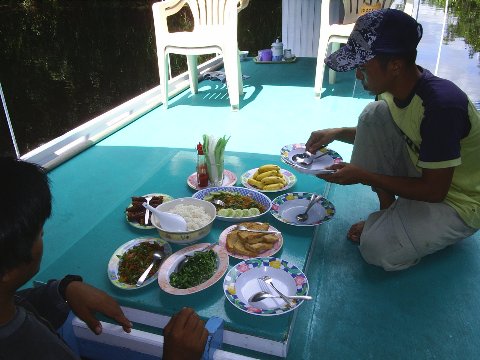
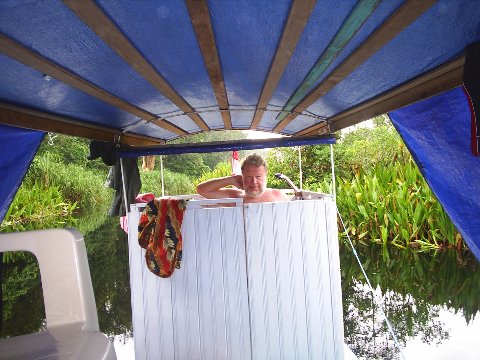
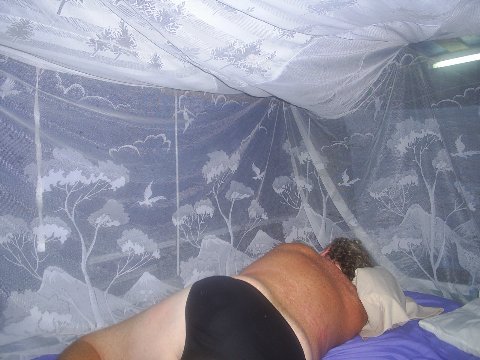
When we came to each post our
guide led us off into the rain forest until we reached the feeding stations.
Some of the orangutans are wild and others are rehabilitated captives whose
habitat was destroyed to plant Palm oil plantations and by logging. Apparently
palm oil is ubiquitous in household products and cosmetics and thousands of
acres of rainforest in Kalimantan are destroyed each year so more plantations
can be established, such is world appetite for the oil.
Many of the urangutans we got to see up close as they followed us up the track or lay in our path. One naughty girl nicked the mozzie repellent out of Phil’s pocket and proceeded to suck it. At the feeding stations the rangers and our guide would make loud animalistic calls and one by one the orangs came. First we’d see rustling high up in a tree, then the branch would slowly bend, they’d grab onto the next tree, climb down a bit, bend that tree, grab the next etc. We laughed as they would grab as many bananas as they possibly could from the platform, before climbing a tree to scoff them or drop a couple on the heads of the scavenging wild boars below. We saw lots of mothers and babies from 1 month to 5 years old and three large males. And, thankfully, not one leech – although I kept my pants tucked into my socks just in case.

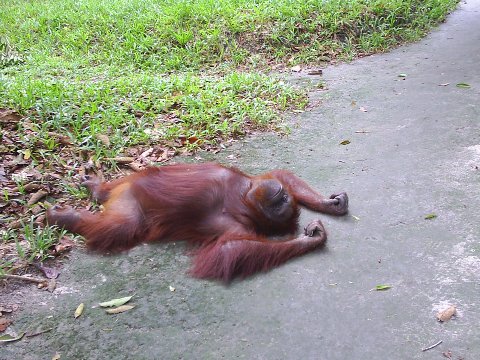
At present we are en route to
Serutu Island, one of the Karimata Island group not far off the coast of
Kalimantan in the South China sea. About 13 miles to go to the island waypoint
and then we have to make our way into the anchorage. At 5.8 knots (1 knot of
current) we hope we will get there before dark.
So much for the strategy of
doing as few overnighters as possible.
The plan was just to do the
overnighters we absolutely had to, to avoid the traffic and rubbish that is
notorious in the seas from Bawean north. That meant about 30 hours from Bawean
to Kumai, Kalimantan. Another 30 from Kumai back across the Karimata Strait to
Nangka Island/reef, and then day hops to the top of Belitung Island, up the E.
side of Bangka Island to the Lingga and Riau Islands, before crossing to
Singapore.
But that’s not the way it
happened. In the event, the rock and reef strewn sea and anchorages around
Nangka, Belitung and Bangka and the fact that no-one else had gone that way,
decided us that we would take the more prudent route via Serutu (240nm) to
Lingga Islands (240nm).
28 October 2005
I’ll definitely be spending my
birthday this year on the high seas. We left Serutu this morning after waiting
there for bad weather, strong wind, heavy rain and squalls to pass through. We
are in the transition season between the south and north monsoons at these
latitudes at this time of year. That apparently means calms and squalls mostly,
with some norwesters (the way we are headed – yuck) thrown in for good
measure. We had a calm trip to Serutu and so far a wonderfully calm trip this
way. Though we still have 190nm (31 hours) to go and anything could happen.
We have already seen many 44
gallon drums and logs floating and hope we won’t be running into those in the
dark. By night time we will be in the middle of the South China Sea, as far from
land on either side as possible so hope that will lessen the chances of meeting
debris.
31 October 2005
We got to Lingga Island in the
dark. As we approached the anchorage one by one hundreds of tiny lights came on
from fishing boats that didn’t show up on radar. With no moon, it was very
dark. Fortunately they lined our route except for one slowcoach who put his
light on only at the last minute and happened to be right in front of us.
Managed to avoid him though.
We were taken by surprise at how
lovely the islands are in this part of Indonesia. Densely forested and green and
mountainous or sand cays topped with coconut palms. There are many tiny bays
with white sand beaches. And the seas are shallow again and coloured like
Queensland waters. Quite similar to the Whitsundays. The islands are only
lightly populated. It’s also amazing how there are no cruising boats here from
Singapore and Malaysia – it would seem to be a fantastic close cruising ground
for them.
Throughout the waters here are “fish trap houses” on stilts. A bamboo house with peaked thatched roof atop a platform, from which a net hangs below like a huge hammock.
We visited a stilt house village. The backs of the houses are over the water – joined to each other by boardwalks – and the fronts of the houses are on the sand. It was a gorgeous place – real film set material. And the people, like just about everyone we’ve met in Indonesia, were very warm and hospitable. Some of the children came to the boat with gifts and we gave them some swim goggles. They were fasting so couldn’t even have a drink of water.
This village had a modern cool
room made of insulated aluminium panels, with a plaque on it apparently
dedicated by some Indonesian government official. They also had a large array of
solar panels in addition to several generators in thatched sheds.
Ramadan finishes on 5 November
apparently. We are amazed at how the people fast all day from 3am until about
5pm (it varies from place to place) – particularly not drinking. Many of the
people in Kumai had flecks of dried spittle around their mouths. And we put our
foot in it several times by offering them drinks. We felt so sorry for them –
in this heat. Our Kalimantan river guide told us that the “singing” we could
hear coming from all the mosques in Kumai almost 24 hours a day was people
reciting from the Koran. One person leads and the others follow. We heard many
women’s voices and all levels of tunefulness. Apparently anyone can have a go.
And it’s all amplified and played from the speakers at the top of the
minarets. The “calling to prayer” – usually just five times a day – is
done by any man who wants to and who has studied the words. It sounds like they
have a roster of some sort. And ability to sing doesn’t come into it.
Tonight we’ll be anchored at
Kentar Island. Singapore is only 90 miles away. With hundreds more Indonesian
islands in between. This place just keeps on going.
3 November 2005
Yesterday afternoon we tied up at Nongsa Point marina amid fancy “Mediterranean style” resort villas, sweeping open bars and restaurant and a special floating deck/pontoon with wrought iron furniture for that romantic dinner over the water. Talk about culture shock.
Last night as we used the
internet on the deck overlooking the water, the pianist played to an audience of
none, the restaurant - all marble topped tables, bamboo chairs and orchids - was
empty. Maybe on the weekend tourists will come across from Singapore to play
golf or have dirty weekends.
Fortunately the marina is just a
shade down at heel and the buildings a teensy bit broken or water damaged,
reminding us that we are, after all, still in Indonesia. But we are only 12
miles from Singapore and we can see the lights twinkling seductively, just
across the water. All we have to do to get there is cross the Singapore Strait.
We are girding our loins, shopping and checking out here before we go.
We crossed the equator a couple
of days ago. Imperceptibly we have inched towards a different climate. We
realise that for some time now the amount of cloud has been increasing, night
time rain squalls have become a daily occurrence and middle of the night
stillness and heat a regular happening. Don’t know whether it is just the
“transition” season between the south and north monsoons or whether this is
just equator weather.
But we have not had a weather
forecast or tide tables since we left Australia. Imagine that cruising in Oz!?
As we head north, the NE monsoon is supposed to set in, giving dry warm weather
in Thailand from December to April.
Some Indonesia Cruising
Information:
Our 3 mth cruising permit (CAIT)
and sponsor letter to allow us to get a 2 month social and educational visa,
cost $US176 (about $A220). Our 2mth visas for Indonesia were $A60 each. We paid
a total of R110,000 (about $A15), a bottle of cask white wine, two cans of beer
and a bottle of coke in bribes. It cost us $US30 to clear into the country at
Benoa, Bali and $US30 to “clear out” ie not clear out of the country but get
harbour clearance. These last 2 payments were made to our agent, not the
officials. We were told we could have cleared in at Mataram in Lombok at no
cost. To clear out of Indonesia will cost us $US30 (paid to the marina), though
we believe it costs nothing to clear from other places near here.
Some yachts checked in at Kupang
and paid $US50 for their agent plus bribes and or gifts to the officials. Others
checked in and out at the same time in Bali.
In addition to your CAIT,
harbour masters at ports want to give you a Surat Izyin Berlayer (SIB) sailing
permit/port clearance and check that you have one from your previous port. This
is the mysterious “clearing out” at Bali, where your SIB requires not just
harbour master approval, but also Immigration and Customs for some reason.
Procedures differ from island to island and no-one knows how the others operate.
Some time in a future life I would love to try and investigate what the
“correct” procedures are. Although I suspect that there may be no answer.
One thing we realised about
halfway through Indonesia is that the CAIT is in English so there’s a fair
possibility that in some of the ports off the beaten track or where their
English is not fantastic, that they have not a clue what it is so insist on the
SIB, which is the paperwork used for Indonesian shipping.
Re fuel. (This is what we have
inferred – it is hard to know definitively as the answer has varied in the few
places we have enquired about or bought fuel) While we have been in Indonesia
the government has removed the domestic price subsidy and restricted access to
diesel by foreign ships, requiring special permits etc for “large” amounts.
We suspect that in drafting their legislation, they have forgotten entirely
about foreign small boats and yachts – who after all are are tiny bee’s dick
of a percentage point of the boats on the move here. Strictly speaking I think,
foreigners are not supposed to get diesel from domestic retail suppliers.
Because their needs are relatively small, yachts are often able to take jerry
cans (or send jerry cans with an “agent”) to a service station and get fuel
that way. (A bribe to the service station owner is apparently required since he
is not supposed to do it. We have not actually gone to a service station
ourselves but did buy 370 litres in jerry cans at the beach at Lombok (R3,800/l)
– our agent had to pay a bribe to get the fuel that time.)
It’s a little harder for motor
boats looking for 1000-2000litres. We were able to get it from Benoa marina in
Bali (R6,000/l) because they had a bowser. But between Argos and Lifeline, we
emptied their diesel supplies and they didn’t know when they would be able to
get more.
We also bought fuel at Kumai
(R5,800/l) which was brought out to us in drums and pumped into our tanks
(faster than Bali marina). We believe there might have been some bribery
involved here too. After reaching Sumbawa, where we realised fuel surplies might
be hard to get, we decided to get fuel “little and often”.
The other fuel related story is
the number of yachts since Kalimantan who also could not get fuel and who
don’t carry enough. Argos and Lifeline have been asked at least 6 times to
supply fuel in anchorages. We have only supplied about 80 litres, but Phil and
Margaret took 300l from their tanks this time and also had supplied yachts with
180 litres fuel earlier in their trip. (As a result. they would have been in a
bad situation by Bali if they had not been able to get fuel.)
Well, that’s Indonesia for us for a while. As I write this we are sitting in Republic of Singapore Yacht Club marina drowning in luxury – it is astoundingly luxurious. I don’t know whether to have a steam bath first or a swim (but I’ll probably do the washing and clean the boat instead). First, though, we’re off to the city to finish clearing in.